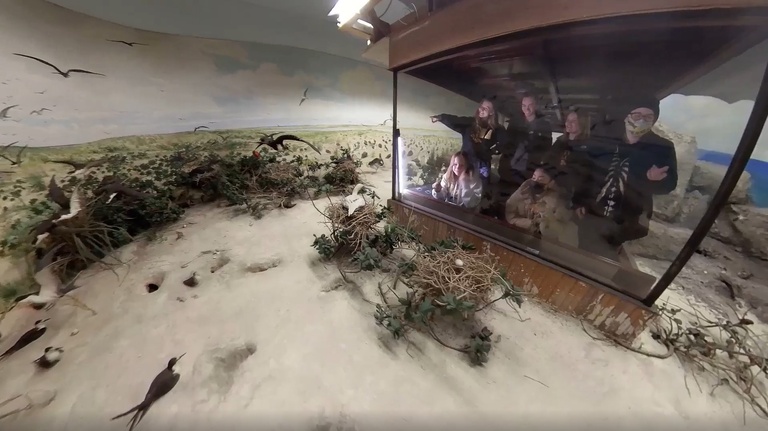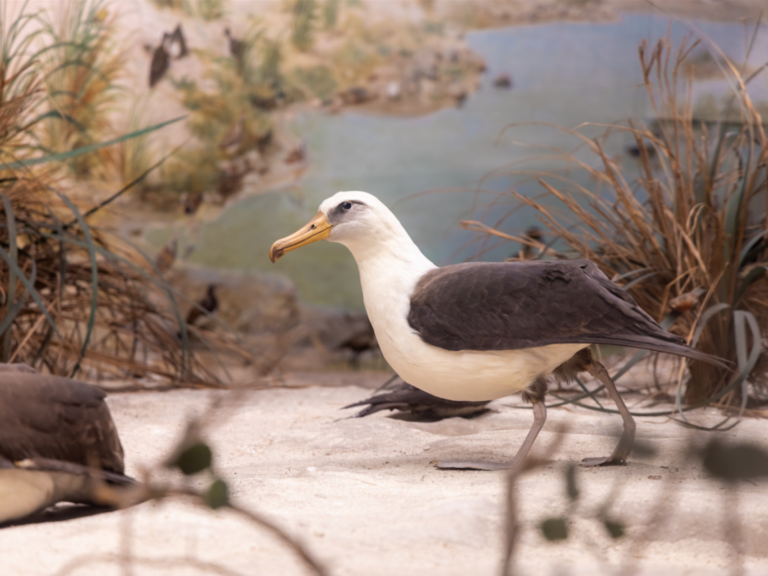IOWA CITY, Iowa — The University of Iowa Museum of Natural History has been awarded a Save America’s Treasures grant to support the preservation of the historic Laysan Island Cyclorama, a one-of-a-kind exhibition that has captivated visitors for more than a century.
Administered by the National Park Service in partnership with the Institute of Museum and Library Services, the National Endowment for the Humanities, and the National Endowment for the Arts, Save America’s Treasures provides funding to protect nationally significant historic properties and collections. The program will fund $750,000 toward the museum’s ongoing restoration efforts.
Created in 1914, the Laysan Island Cyclorama immerses visitors in the environment of Kauō (or Laysan), an atoll in the Northwest Hawaiian Islands known for its extraordinary bird populations. Combining art, science, and conservation, the exhibition features a 138-foot painted mural, over 100 mounted birds representing 24 species (including 3 now extinct species), and a richly detailed foreground of nests, eggs, and native flora. It was one of the first 360-degree immersive exhibits (panorama or cyclorama) dedicated to a singular ecosystem and remains unique in the world today.
The newly awarded grant will fund crucial conservation work including updated professional assessments of the mural, specimens, and exhibition materials; cleaning and repair of the mural, mounts, and foreground elements damaged by time, dust, and environmental stress; and improvements to environmental controls and building systems to ensure long-term preservation.
“The Laysan Island Cyclorama is a national treasure that blends science, art, and environmental history in a way that is each breathtaking, historically significant, and deeply relevant today,” says Pentacrest Museums Director Liz Crooks.
Pentacrest Museums Communications & Engagement Specialist Jessica Smith adds, “This support from the Save America’s Treasures program allows us to continue and complete the work our donors have made possible in preserving the exhibition for future generations while sharing its powerful story of both ecological wonder and human impact.”
The cyclorama traces its origins to University of Iowa zoologist and museum director Charles C. Nutting, who first visited Laysan in 1902 and later organized a return expedition to document the island’s environment. Completed under the direction of Homer Dill with muralist Charles Corwin, the exhibition was hailed at the time as “the largest and most spectacular of all the world’s habitat groups of birds” by zoologist William T. Hornaday.
Today, the cyclorama continues to educate and inspire audiences, offering a rare immersive view of an ecosystem forever changed by human activity. Its restoration will ensure that the UI Museum of Natural History can continue to use this exhibition to teach lessons of museology, biology, environmental stewardship, resilience, and interconnectedness.
For more information about the University of Iowa Museum of Natural History and the Laysan Island Cyclorama, visit https://mnh.uiowa.edu/ or read the Iowa Mag story which started the restoration fund here: https://magazine.foriowa.org/story.php?ed=true&storyid=2194
Media Contact:
Jessica Smith
University of Iowa Pentacrest Museums
Communications & Engagement Specialist
jessica-smith-7@uiowa.edu


